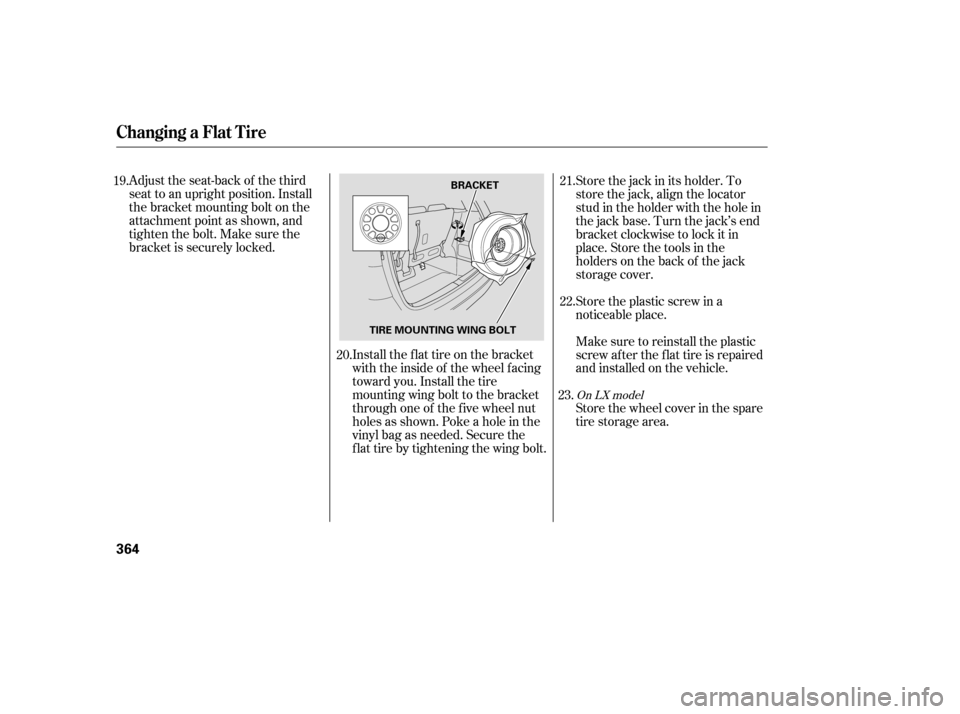Page 364 of 414
Tighten the wheel nuts securely in
the same crisscross pattern. Have
the wheel nut torque checked at
the nearest automotive service
f acility.
Tighten the wheel nuts to:Remove the bracket from the jack
storageareabyunscrewingthe
bracket mounting bolt.
Put the f lat tire in the supplied
vinyl bag. This bag is in the jack
storage area. You will f ind a u-shaped slit on the
carpet behind the seat bottom of
the third seat. Pull up the carpet at
the slit, and remove the plastic
screw with a coin.
Lower the vehicle to the ground,
and remove the jack. Put on the spare tire. Put the
wheel nuts back on f inger-tight,
then tighten them in a crisscross
pattern with the wheel nut wrench
until the wheel is f irmly against
the hub. Do not try to tighten
them f ully.
13.
14. 15.17.
18.
16.
CONT INUED
Changing a Flat T ire
T aking Care of t he Unexpect ed
363
BRACKET BRACKET MOUNTING BOLT
94 lbf·ft (127 N·m , 13 kgf·m)
Page 365 of 414

Adjust the seat-back of the third
seat to an upright position. Install
thebracketmountingboltonthe
attachment point as shown, and
tighten the bolt. Make sure the
bracket is securely locked.Install the flat tire on the bracket
with the inside of the wheel facing
toward you. Install the tire
mounting wing bolt to the bracket
through one of the f ive wheel nut
holes as shown. Poke a hole in the
vinyl bag as needed. Secure the
flat tire by tightening the wing bolt.Store the jack in its holder. To
store the jack, align the locator
stud in the holder with the hole in
the jack base. Turn the jack’s end
bracket clockwise to lock it in
place. Store the tools in the
holders on the back of the jack
storage cover.
Store the plastic screw in a
noticeable place.
Make sure to reinstall the plastic
screw af ter the f lat tire is repaired
andinstalledonthevehicle.
Store the wheel cover in the spare
tire storage area.
19.
20.21.
22.
23.
On LX model
Changing a Flat T ire
364
BRACKET
TIRE MOUNTING WING BOLT
Page 366 of 414
Place the flat tire face down on the
attachment point. Put the tire
mountingwingboltinthe
attachment point through one of
the f ive wheel nut holes as shown.
Poke holes in the vinyl bag. Secure
the f lat tire by tightening the wing
bolt.
Follow step 21 through 24 on page.
When the third seat is f olded, the
f lat tire is secured to the f loor on top
of the f olded seat.
Pull up the U-shaped carpet piece,
f old it, and tack the end under the
carpet.
Remove the plastic screw as
described in the previous
procedure.
Install the spare tire storage cover.
1.
3.
4.
2.
364
24.
Changing a Flat T ire
St oring a Flat T ire on t he Folded
Third Seat
T aking Care of t he Unexpect ed
365
Loose items can fly around the
interior in a crash and could
seriously injure the occupants.
Store the wheel, jack, and tools
securely before driving.
Page 374 of 414

However, if the brake pedal does not
f eel normal, you should take
immediate action. A problem in one
part of the system’s dual circuit
design will still give you braking at
two wheels. You will f eel the brake
pedal go down much f arther bef ore
the vehicle begins to slow down, and
you will have to press harder on the
pedal.
Slow down by shif ting to a lower
gear, and pull to the side of the road
when it is saf e. Because of the long
distance needed to stop, it is
hazardous to drive the vehicle. You
should have it towed and repaired as
soon as possible (seeon page ). If you must drive the vehicle a short
distance in this condition, drive
slowly and caref ully.
If the brake system indicator comes
on while driving, the brake f luid level
is probably low. Press lightly on the
brake pedal to see if it f eels normal.
If it does, check the brake f luid level
thenexttimeyoustopataservice
station (see page ).
If the f luid level is low, take your
vehicle to a dealer, and have the
brake system inspected f or leaks or
worn brake pads. The brake system
indicator normally
comesonwhenyou
turn the ignition switch to ON (II),
and as a reminder to check the
parking brake. It will stay on if you
do not f ully release the parking
brake. If the ABS indicator and the VSA
indicator come on with the brake
system indicator, have the vehicle
inspected by your dealer
immediately.
You will also see a ‘‘CHECK BRAKE
SYSTEM’’ message on the multi-
inf ormation display when this
indicator comes on.
335
381
On Touring model
Emergency
Towing
Brake System Indicator
T aking Care of t he Unexpect ed
373
U.S. Canada
Page 382 of 414

�µ�µ
If your vehicle needs to be towed,
call a prof essional towing service or
organization. Never tow your vehicle
with just a rope or chain. It is very
dangerous.
Therearetwowaystotowyour
vehicle.
The operator
loads your vehicle on the back of a
truck. With the f ront wheels on the ground,
it is best to tow the vehicle no farther
than 50 miles (80 km), and keep the
speedbelow35mph(55km/h).
The tow
truck uses two pivoting arms that go
under the tires (f ront or rear) and lif t
them of f the ground. The other two
tires remain on the ground.
If , due to damage, your vehicle must
be towed with the f ront wheels on
the ground, do the f ollowing:
Release the parking brake.
Start the engine.
ShifttoD,thentoN.
Turn of f the engine.
CONT INUED
Flat bed Equipment Wheel-lif t Equipment
T his is the best way to
transport your vehicle, and it is
only way to transport a Touring
model. T his is
an acceptable way to tow your
vehicleexceptfortheTouring
model.
Emergency T owing
T aking Care of t he Unexpect ed
381
Improper towing preparation will
damage the transmission. Follow the
above procedure exactly. If you cannot
shif t the transmission or start the
engine, your vehicle must be
transported with the f ront wheels of f
the ground.
Page 383 of 414
If you decide to tow your vehicle
with all f our wheels on the ground,
make sure you use a properly-
designed and attached tow bar.
Prepare the vehicle for towing as
described previously, and leave the
ignition switched in the
ACCESSORY (I) position so the
steering wheel does not lock. Make
sure the radio and any items plugged
into the accessory power sockets are
turned of f so they do not run down
the battery.
Emergency T owing
382
The steering system can be damaged if
the steering wheel is locked. Leave the
ignition switch in Accessory (I), and
make sure the steering wheel turns
f reely bef ore you begin towing.Trying to lif t or tow your vehicle by the
bumpers will cause serious damage.
The bumpers are not designed to
support the vehicle’s weight.
Page 387 of 414

�µ�µ
�Î
�Î
�Î
�Î�Î
�Î �Î
�Î
Specif ications
386
Dimensions
WeightsCapacities Air Conditioning
Engine 201.0 in (5,106 mm)
77.1 in (1,958 mm)
66.8 in (1,697 mm) 66.7 in (1,694 mm)
118.1 in (3,000 mm) 68.8 in (1,748 mm)
70.0 in (1,778 mm)
8,210 lbs (9,815 kg)
Length
Width
Height
Wheelbase
Track
Gross vehicle weight rating
Gross combined weight
rating (GCWR)
See the tire information label atta-
ched to the driver’s doorjamb.
Excluding the oil remaining in the engine. 0.16 US gal (0.6
)
Including the coolant in the reserve tank and that remaining in the
engine.
Reserve tank capacity:
Fuel tank
Engine
coolant
Engine oil
Automatic
transmission
fluid
Windshield
washer
reservoir
4.8 US qt (4.5
)
2.6 US qt (2.5)
8.5 US qt (8.0
)
3.3 US qt (3.1)
5.3 US qt (5.0)
4.2 US qt (4.0
)
4.5 US qt (4.3
)
2.48 US gal (9.4
)
1.85 US gal (7.0)
Refrigerant type
Charge quantity
Lubricant type
32 34 oz (850 900 g)
ND-OIL8
HFC-134a (R-134a)
Water cooled 4-stroke
SOHC VTEC, 6-cylinder, gasoline engine
Type
BorexStroke
Displacement
Compression ratio
Spark plugs
PKJ16DR-M11 IZFR5K-11
10.0 : 1
212 cu-in (3,471 cm
)
3.50 x 3.66 in (89.0 x 93.0 mm)
Front
Rear
1: LX
2 : EX, Touring
1:
2:Change
Total
Change
Including
filter
Without
filter
Total
Change
Total
U.S. Vehicles
Canada Vehicles Approx.
21 US gal (80
)
NGK:
DENSO:
1
2 1
2
Page 390 of 414

�µ
The temperature grades are A (the
highest), B, and C, representing the
tire’s resistance to the generation of
heat and its ability to dissipate heat
when tested under controlled
conditions on a specif ied indoor
laboratory test wheel. Sustained high
temperature can cause the material
of the tire to degenerate and reduce
tire life, and excessive temperature
can lead to sudden tire f ailure. The
grade C corresponds to a level of
perf ormance which all passenger car
tires must meet under the Federal
Motor Vehicle Saf ety Standard No.
109. Grades B and A represent
higher levels of perf ormance on the
laboratory test wheel than the
minimum required by law. Warning: The temperature grade f or
this tire is established f or a tire that
is properly inf lated and not over-
loaded. Excessive speed, underinf la-
tion, or excessive loading, either
separately or in combination, can
cause heat buildup and possible tire
f ailure.
DOT T ire Quality Grading (U.S. Vehicles)
Temperature A,B,C
T echnical Inf ormation
389